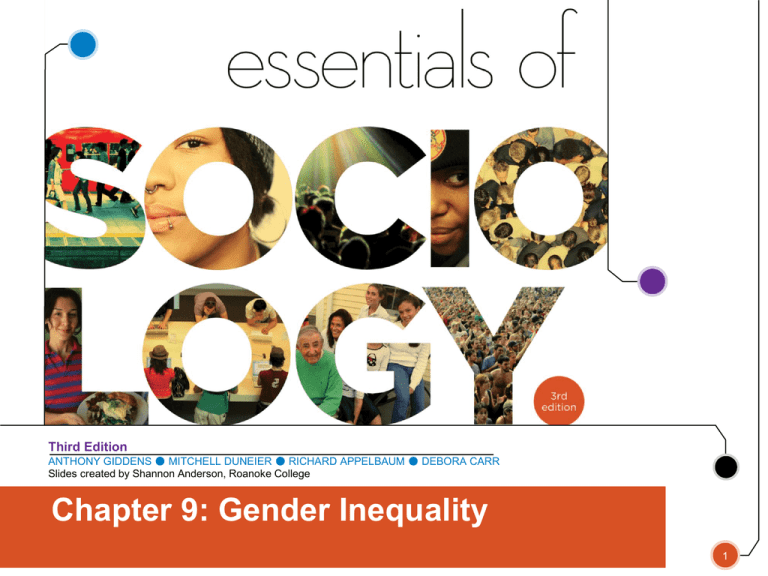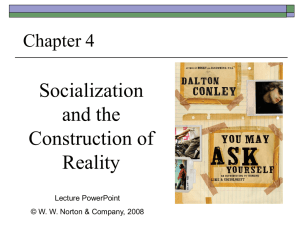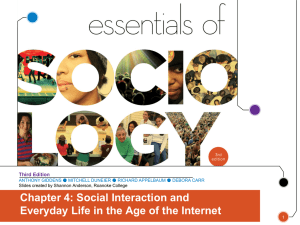
Third Edition
ANTHONY GIDDENS ● MITCHELL DUNEIER ● RICHARD APPELBAUM ● DEBORA CARR
Slides created by Shannon Anderson, Roanoke College
Chapter 9: Gender Inequality
1
Overarching questions
• Is gender biological, social, or both?
• Why is power invested in the male category?
• What does gender inequality look like and
why?
• Why is gendered violence so commonplace?
© 2011 W. W. Norton Co., Inc.
2
“Gender warrior”
© 2011 W. W. Norton Co., Inc.
3
Sex and gender
•
As sociologists we begin by separating sex
and gender:
–
–
Sex is a biological category.
Gender is a social category.
© 2011 W. W. Norton Co., Inc.
4
Biological differentiation
• Chromosomes
– XX and XY
– XXY or XYY can occur in rare cases
• Hormones
– Estrogen and testosterone
• The question: How important is biology in
explaining behavioral differences?
© 2011 W. W. Norton Co., Inc.
5
Socialization and environment
• Gender roles are learned via socialization, both
early on and throughout life.
• Gender socialization now begins prior to birth.
• Varying social environments produce different
versions of “man” and “woman.”
• Gender is socially constructed.
© 2011 W. W. Norton Co., Inc.
6
Language and gender
socialization
• The language we use is not gender neutral; it is
part of everyday life.
• Much language glorifies the male category and
demeans the female.
© 2011 W. W. Norton Co., Inc.
7
Gendered language
• Janet Shibley Hyde notes patterns in
gendered language:
– Male as normative/female as exception
– Parallel words
– Infantilization of women
• Allowing language to devalue women and girls
is part of socialization and contributes to
inequality.
© 2011 W. W. Norton Co., Inc.
8
Doing gender
•
•
Gender is more than simply a learned role,
though that role is important.
Gender is something to be done—
accomplished—each day.
© 2011 W. W. Norton Co., Inc.
9
Gender in time and space
• Gender has not always looked the same:
– Consider changes in gender roles over the past 50–
100 years here in the United States.
• Gender does not look the same across cultures:
– Mead’s research in New Guinea (1930s) showed
significant variation between tribes and with
outside cultures.
© 2011 W. W. Norton Co., Inc.
10
Gender in time and space
• Gender is not always confined to male and
female.
– Example: the Zuni berdache
© 2011 W. W. Norton Co., Inc.
11
Gender systems
• Patriarchy refers to the gender system in
societies where men are dominant.
• Nearly all societies are patriarchal, though the
degree varies greatly.
• Gender inequality refers to the difference in
power, status, access, and choices between
men and women.
© 2011 W. W. Norton Co., Inc.
12
Figure 9.1 Women’s Participation in the Labor Force in
the United States
Essentials Of Sociology, 3rd Edition
Copyright © 2011 W.W. Norton & Company
Inequality at work
• Jobs gender-typed female are valued less and
paid less.
• The gender gap in earnings has narrowed but
remains in place (1970–2008).
– FT employees: 62% 80%
– Hourly: 64% 79%
– All employees: 46% 61%
© 2011 W. W. Norton Co., Inc.
14
Inequality at work
• Policies like comparable worth aim to
remedy the pay gap, but have drawbacks.
• Informal structures such as the glass ceiling
and glass escalator reproduce gender
inequality by favoring male employees.
• Sexual harassment also continues to be a way
for men to dominate women in the workplace.
© 2011 W. W. Norton Co., Inc.
15
Gender and family
• The ongoing difficulty of balancing work and
family rests largely on women.
– Managers see women as more tied to family than
work.
– This affects women’s ability to get responsible
positions.
• Women also continue to do significantly more
housework than their spouses.
© 2011 W. W. Norton Co., Inc.
16
Gender and education
• Differential treatment in schools perpetuates
traditional gender socialization.
– More attention—positive and negative—is paid to
boys.
• But something is changing: Today girls
outperform boys on many measures.
© 2011 W. W. Norton Co., Inc.
17
Gender and politics
• In the United States, men outnumber women at
all levels of political office, but especially at
the state and national levels.
• Globally, some thirty-eight countries have had
female heads of state (not including the United
States), but in 2009 women made up only 18
percent of national parliaments (legislatures).
© 2011 W. W. Norton Co., Inc.
18
Gender Empowerment
Around the World
Year Women
Could Vote
Income
Ratio
1919
1913
1906
1902
1918
1917
1946
1947
1920
2006
0.67
0.77
0.73
0.59
0.65
0.65
0.55
0.53
0.79
0.27
Essentials Of Sociology, 3rd Edition
47%
36%
42%
30%
31%
25%
33%
24%
17%
23%
32%
31%
29%
37%
38%
37%
43%
31%
43%
10%
51%
51%
55%
57%
50%
56%
53%
45%
56%
21%
0
%
Copyright © 2011 W.W. Norton & Company
10%
20%
Ten Countries
Ranked by Gender
Empowerment Measure
30%
% of Seats in Parliament
% of Legislators, Senior
Officials, & Managers
40%
% of Professional &
Technical Workers
* Ratio of estimate female to male earned income
© 2011 W. W. Norton Co., Inc.
SOURCE: UNDP 2009a.
50%
19
Violence against women
• Violence against women is institutionalized in
varying ways around the world.
–
–
–
–
–
–
Dowry disputes in India
Sharia law in Islamic countries
Foot-binding in China
Genital mutilation in many countries
Forced prostitution (sex trafficking)
Culture of misogyny
© 2011 W. W. Norton Co., Inc.
20
Rape
• Nearly one-quarter of women say they have
been forced into a sexual encounter, but only 3
percent of men acknowledge coercive sex.
• College campuses are a prime location for
sexual violence and attempted sexual violence.
– Rape
– Coercion
– Stalking
© 2011 W. W. Norton Co., Inc.
21
Explaining gender inequality
• Functionalism
• Feminist theories
– Liberal feminism
– Radical feminism
– Black feminism
© 2011 W. W. Norton Co., Inc.
22
Functionalist theory
• Sees gender differences as good for societal
harmony
• Problems:
– Assumes gender roles are universal and static
– Puts the broad harmony over problems caused by
gender inequity
© 2011 W. W. Norton Co., Inc.
23
Feminist theories
• An activist approach that sees inequality as a
systemic wrong that must be challenged
• Today feminist theory is used to explain
inequality in many social institutions and
concerns aside from those explicitly dealing with
gender.
• Many versions of feminist theory; they do not
necessarily agree with each other
© 2011 W. W. Norton Co., Inc.
24
This concludes the Lecture
PowerPoint Presentation for
Chapter 9: Gender Inequality
For more learning resources, please visit our online StudySpace at:
http://www.wwnorton.com/college/soc/essentials-of-sociology9/
W. W. Norton & Company
Independent and Employee-Owned
© 2011 W. W. Norton Co., Inc.
25
Clicker Questions
1. Your friend Meghan overhears you talking about the difference between sex
and gender with your classmate Roger. Confused, Meghan chimes in:
“Wait a minute! I thought sex and gender were the same thing!” You
explain that
a. sex refers to the physical differences in the body, whereas gender concerns
the psychological, social, and cultural differences between males and
females.
b. sex is what couples do to conceive, whereas gender is an attribute of their
baby.
c. a culture’s understanding of gender determines what types of physical
intimacy constitute sex.
d. sex concerns the psychological, social, and cultural differences between
males and females, whereas gender refers to the physical differences in the
body.
© 2011 W. W. Norton Co., Inc.
26
Clicker Questions
2. What is patriarchy?
a. the name given to societies in which property is passed down
by the male lineage
b. the name given to societies in which Eastern Orthodoxy is the
main religion
c. the name given to societies in which women are treated as
property
d. the name given to male dominance in a society
© 2011 W. W. Norton Co., Inc.
27
27
Clicker Questions
3. An important economic trend of the past thirty years has been
the _____ of the gender gap in earnings.
a. widening
b. narrowing
c. disappearance
d. appearance
© 2011 W. W. Norton Co., Inc.
28
Clicker Questions
4. According to sociologists, why are women so often the target
of sexual violence?
a. Men are socialized to regard women as sexual objects and are
socialized into a sense of sexual entitlement.
b. Women are physically weaker than men and are unable to
resist male advances.
c. In an era of rapidly changing gender roles, males are often
confused by the signals that women send them regarding their
willingness to have sex.
d. Men are unable to regulate their behavior when experiencing
aroused sexual passion.
© 2011 W. W. Norton Co., Inc.
29
Clicker Questions
5. What does it mean for men and women to “do gender”?
a. To “do gender” means to follow traditional conceptions of the
responsibilities of men and women in everyday life and to reinforce the
idea that gender is a natural means for society to differentiate itself.
b. To “do gender” means to challenge traditional conceptions of the
responsibilities of men and women in everyday life and to attack the idea
that gender is a natural means for society to differentiate itself.
c. To “do gender” means to take the traditional role of the opposite gender
(men acting as women and women as men). This normally happens in
special circumstances, such as a fancy-dress party where men come as
women and women as men or in single-parent homes when Daddy has to
change diapers or Mommy has to repair the sink.
d. To “do gender” refers to the process by which children learn about
traditional conceptions of gender roles.
© 2011 W. W. Norton Co., Inc.
30
Clicker Questions
6. Gender typing occurs when
a. men and women are concentrated in different occupations.
b. men dominate the economic power in a society.
c. men in traditionally female jobs such as teaching find
themselves rising to the top of the organizational ladder.
d. there is great inequality between men and women in terms of
wealth, income, and status.
© 2011 W. W. Norton Co., Inc.
31
Clicker Questions
7. Which of the following statements would be rejected by
sociologists who endorse the view that gender is socially
constructed?
a. Sex is biologically determined and gender is culturally learned.
b. Both sex and gender are socially constructed.
c. There is no biological basis for gender differences.
d. Gender identities emerge in relation to perceived sex
differences in society and in turn help to shape those
differences.
© 2011 W. W. Norton Co., Inc.
32
Art Presentation Slides
Chapter 9
Gender Inequality
Anthony Giddens
Mitchell Duneier
Richard P. Appelbaum
Deborah Carr
Chapter Opener
Essentials Of Sociology, 3rd Edition
Copyright © 2011 W.W. Norton & Company
Many children’s toys may promote gender stereotyping.
Essentials Of Sociology, 3rd Edition
Copyright © 2011 W.W. Norton & Company
This photo (left), dated November 30, 1952, shows George
Jorgensen before his sex change. After he was discharged from
the U.S. Army he traveled to Copenhagen, Denmark, where he
had a sex change operation. After the operation he changed his
name to Christine. Christine Jorgensen (right), returning from
a night-club engagement in Cuba in 1953.
Essentials Of Sociology, 3rd Edition
Copyright © 2011 W.W. Norton & Company
A we’wha (or berdache) of the Zuni people of New Mexico.
Berdaches often behaved like persons of the opposite gender.
Essentials Of Sociology, 3rd Edition
Copyright © 2011 W.W. Norton & Company
Figure 9.1 Women’s Participation in the Labor Force in
the United States
Essentials Of Sociology, 3rd Edition
Copyright © 2011 W.W. Norton & Company
Figure 9.2 Women at Work
Essentials Of Sociology, 3rd Edition
Copyright © 2011 W.W. Norton & Company
Figure 9.3 The Gender Pay Gap
Essentials Of Sociology, 3rd Edition
Copyright © 2011 W.W. Norton & Company
Factory worker in Chang zhou, China, assembling
parts for switch-gears.
Essentials Of Sociology, 3rd Edition
Copyright © 2011 W.W. Norton & Company
Sociologist Christine Williams asserts than men in
female-dominated professions, such as this elementary school
teacher, are routinely promoted to top administrative
positions and face constant pressure to advance.
Essentials Of Sociology, 3rd Edition
Copyright © 2011 W.W. Norton & Company
U.S. Marine Michael Mink discusses school behavior
notes that came home in his sons’ back-packs.
Essentials Of Sociology, 3rd Edition
Copyright © 2011 W.W. Norton & Company
Gender Empowerment Around the
World
Year Women
Could Vote
Income
Ratio
1919
1913
1906
1902
1918
1917
1946
1947
1920
2006
0.67
0.77
0.73
0.59
0.65
0.65
0.55
0.53
0.79
0.27
Essentials Of Sociology, 3rd Edition
47%
36%
42%
30%
31%
25%
33%
24%
17%
23%
32%
31%
29%
37%
38%
37%
43%
31%
43%
10%
51%
51%
55%
57%
50%
56%
53%
45%
56%
21%
0
%
Copyright © 2011 W.W. Norton & Company
10%
20%
Ten Countries
Ranked by Gender
Empowerment Measure
30%
% of Seats in Parliament
% of Legislators, Senior
Officials, & Managers
40%
% of Professional &
Technical Workers
* Ratio of estimate female to male earned income
© 2011 W. W. Norton Co., Inc.
SOURCE: UNDP 2009a.
50%
Why would a functionalist agree that the division of labor
between the homemaking wife and breadwinning husband
in this Japanese household is ideal?
Essentials Of Sociology, 3rd Edition
Copyright © 2011 W.W. Norton & Company
Surrounded by minority women at the Houston Civic Center?
Essentials Of Sociology, 3rd Edition
Copyright © 2011 W.W. Norton & Company
Globalization and Everyday Life
Essentials Of Sociology, 3rd Edition
Copyright © 2011 W.W. Norton & Company
Globalization and Everyday Life
Essentials Of Sociology, 3rd Edition
Copyright © 2011 W.W. Norton & Company
W.W. Norton & Company
Independent and Employee-Owned
This concludes the Art Presentation Slides
Slide Set for Chapter 9
Essentials Of Sociology
THIRD EDITION
by
Anthony Giddens
Mitchell Duneier
Richard P. Appelbaum
Deborah Carr










